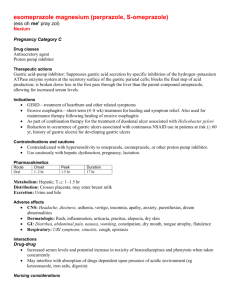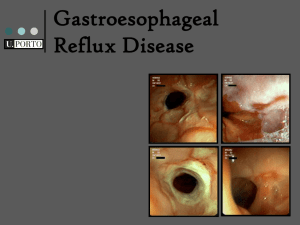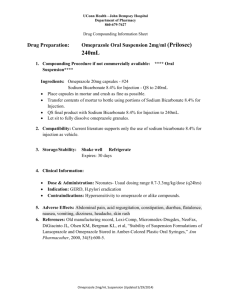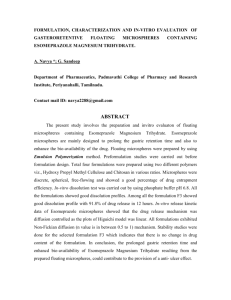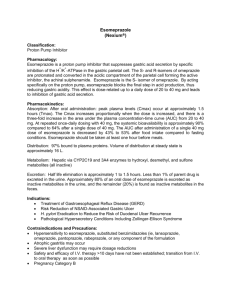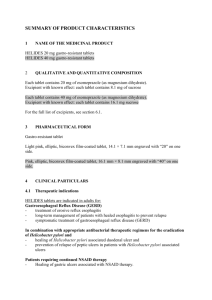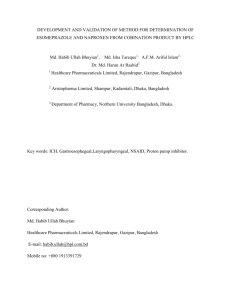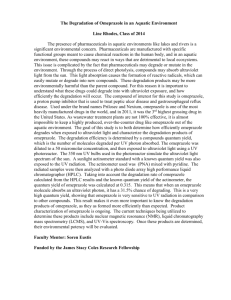Annex I: CSP In PAR: Proposed CSP with assessor comments, if any
advertisement
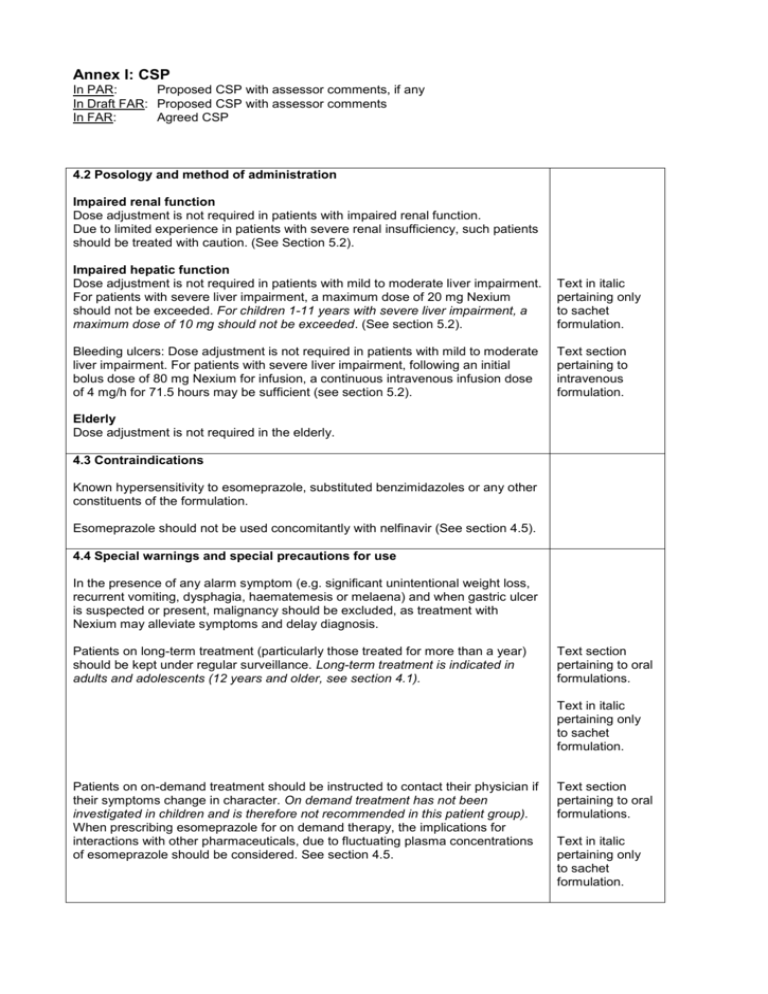
Annex I: CSP In PAR: Proposed CSP with assessor comments, if any In Draft FAR: Proposed CSP with assessor comments In FAR: Agreed CSP 4.2 Posology and method of administration Impaired renal function Dose adjustment is not required in patients with impaired renal function. Due to limited experience in patients with severe renal insufficiency, such patients should be treated with caution. (See Section 5.2). Impaired hepatic function Dose adjustment is not required in patients with mild to moderate liver impairment. For patients with severe liver impairment, a maximum dose of 20 mg Nexium should not be exceeded. For children 1-11 years with severe liver impairment, a maximum dose of 10 mg should not be exceeded. (See section 5.2). Text in italic pertaining only to sachet formulation. Bleeding ulcers: Dose adjustment is not required in patients with mild to moderate liver impairment. For patients with severe liver impairment, following an initial bolus dose of 80 mg Nexium for infusion, a continuous intravenous infusion dose of 4 mg/h for 71.5 hours may be sufficient (see section 5.2). Text section pertaining to intravenous formulation. Elderly Dose adjustment is not required in the elderly. 4.3 Contraindications Known hypersensitivity to esomeprazole, substituted benzimidazoles or any other constituents of the formulation. Esomeprazole should not be used concomitantly with nelfinavir (See section 4.5). 4.4 Special warnings and special precautions for use In the presence of any alarm symptom (e.g. significant unintentional weight loss, recurrent vomiting, dysphagia, haematemesis or melaena) and when gastric ulcer is suspected or present, malignancy should be excluded, as treatment with Nexium may alleviate symptoms and delay diagnosis. Patients on long-term treatment (particularly those treated for more than a year) should be kept under regular surveillance. Long-term treatment is indicated in adults and adolescents (12 years and older, see section 4.1). Text section pertaining to oral formulations. Text in italic pertaining only to sachet formulation. Patients on on-demand treatment should be instructed to contact their physician if their symptoms change in character. On demand treatment has not been investigated in children and is therefore not recommended in this patient group). When prescribing esomeprazole for on demand therapy, the implications for interactions with other pharmaceuticals, due to fluctuating plasma concentrations of esomeprazole should be considered. See section 4.5. Text section pertaining to oral formulations. Text in italic pertaining only to sachet formulation. When prescribing esomeprazole for eradication of Helicobacter pylori possible drug interations for all components in the triple therapy should be considered. Clarithromycin is a potent inhibitor of CYP3A4 and hence contraindications and interactions for clarithromycin should be considered when the triple therapy is used in patients concurrently taking other drugs metabolised via CYP3A4 such as cisapride. Text section pertaining to tablet formulation. This medicinal product contains sucrose. Patients with rare hereditary problems of fructose intolerance, glucose-galactose malabsorption or sucrase-isomaltase insufficiency should not take this medicine. Text section pertaining to oral formulations. Treatment with proton pump inhibitors may lead to slightly increased risk of gastrointestinal infections such as Salmonella and Campylobacter (see section 5.1). Co-administration of esomeprazole with atazanavir is not recommended (see section 4.5). If the combination of atazanavir with a proton pump inhibitor is judged unavoidable, close clinical monitoring is recommended in combination with an increase in the dose of atazanavir to 400 mg with 100 mg of ritonavir; esomeprazole 20 mg should not be exceeded. Esomeprazole is a CYP2C19 inhibitor. When starting or ending treatment with esomeprazole, the potential for interactions with drugs metabolised through CYP2C19 should be considered. An interaction is observed between clopidogrel and omeprazole (see section 4.5). The clinical relevance of this interaction is uncertain. As a precaution, concomitant use of esomeprazole and clopidogrel should be discouraged. Interference with laboratory tests Increased CgA level may interfere with investigations for neuroendocrine tumours. To avoid this interference, esomeprazole treatment should be temporarily stopped for at least five days before CgA measurements. Esomeprazole, as all acid-blocking medicines, may reduce the absorption of vitamin B12 (cyanocobalamin) due to hypo- or achlorhydria. This should be considered in patients with reduced body stores or risk factors for reduced vitamin B12 absorption on long-term therapy. 4.5 Interaction with other medicinal products and other forms of interaction Effects of esomeprazole on the pharmacokinetics of other drugs Medicinal products with pH dependent absorption The decreased intragastric acidity during treatment with esomeprazole, might increase or decrease the absorption of drugs if the mechanism of absorption is influenced by gastric acidity. In common with the use of other inhibitors of acid secretion or antacids, the absorption of ketoconazole and itraconazole can decrease and the absorption of digoxin can increase during treatment with esomeprazole. Concomitant treatment with omeprazole (20 mg daily) and digoxin in healthy subjects increased the bioavailability of digoxin by 10% (up to 30% in two out of ten subjects). Digoxin toxicity has been rarely reported. However, caution should be exercised when esomeprazole is given at high doses in elderly patients. Therapeutic drug monitoring of digoxin should then be reinforced. Omeprazole has been reported to interact with some protease inhibitors. The clinical importance and the mechanisms behind these reported interactions are not always known. Increased gastric pH during omeprazole treatment may change the absorption of the protease inhibitors. Other possible interaction mechanisms are via inhibition of CYP 2C19. For atazanavir and nelfinavir, decreased serum levels have been reported when given together with omeprazole Mallversion 2008-04-07 2(6) and concomitant administration is not recommended. Co-administration of omeprazole (40 mg once daily) with atazanavir 300 mg/ritonavir 100 mg to healthy volunteers resulted in a substantial reduction in atazanavir exposure (approximately 75% decrease in AUC, Cmax and Cmin). Increasing the atazanavir dose to 400 mg did not compensate for the impact of omeprazole on atazanavir exposure. The coadministration of omeprazole (20 mg qd) with atazanavir 400 mg/ritonavir 100 mg to healthy volunteers resulted in a decrease of approximately 30% in the atazanavir exposure as compared with the exposure observed with atazanavir 300 mg/ritonavir 100 mg qd without omeprazole 20 mg qd. Coadministration of omeprazole (40 mg qd) reduced mean nelfinavir AUC, Cmax and Cmin by 36–39 % and mean AUC, Cmax and Cmin for the pharmacologically active metabolite M8 was reduced by 75-92%. For saquinavir (with concomitant ritonavir), increased serum levels (80-100%) have been reported during concomitant omeprazole treatment (40 mg qd). Treatment with omeprazole 20 mg qd had no effect on the exposure of darunavir (with concomitant ritonavir) and amprenavir (with concomitant ritonavir). Treatment with esomeprazole 20 mg qd had no effect on the exposure of amprenavir (with and without concomitant ritonavir). Treatment with omeprazole 40 mg qd had no effect on the exposure of lopinavir (with concomitant ritonavir). Due to the similar pharmacodynamic effects and pharmacokinetic properties of omeprazole and esomeprazole, concomitant administration with esomeprazole and atazanavir is not recommended and concomitant administration with esomeprazole and nelfinavir is contraindicated. Drugs metabolised by CYP2C19 Esomeprazole inhibits CYP2C19, the major esomeprazole metabolising enzyme. Thus, when esomeprazole is combined with drugs metabolised by CYP2C19, such as diazepam, citalopram, imipramine, clomipramine, phenytoin etc., the plasma concentrations of these drugs may be increased and a dose reduction could be needed. This should be considered especially when prescribing esomeprazole for on demand therapy. Concomitant administration of 30 mg esomeprazole resulted in a 45% decrease in clearance of the CYP2C19 substrate diazepam. Concomitant administration of 40 mg esomeprazole resulted in a 13% increase in trough plasma levels of phenytoin in epileptic patients. It is recommended to monitor the plasma concentrations of phenytoin when treatment with esomeprazole is introduced or withdrawn. Omeprazole (40 mg once daily) increased voriconazole (a CYP2C19 substrate) Cmax and AUCτ by 15% and 41%, respectively. Text in italic pertaining to oral formulations. Concomitant administration of 40 mg esomeprazole to warfarin-treated patients in a clinical trial showed that coagulation times were within the accepted range. However, post-marketing, a few isolated cases of elevated INR of clinical significance have been reported during concomitant treatment. Monitoring is recommended when initiating and ending concomitant esomeprazole treatment during treatment with warfarin or other coumarine derivatives. In healthy volunteers, concomitant administration of 40 mg esomeprazole resulted in a 32% increase in area under the plasma concentration-time curve (AUC) and a 31% prolongation of elimination half-life(t1/2) but nosignificant increase in peak plasma levels of cisapride. The slightly prolonged QTc interval observed after administration of cisapride alone, was not further prolonged when cisapride was given in combination with esomeprazole (see also section 4.4). Esomeprazole has been shown to have no clinically relevant effects on the pharmacokinetics of amoxicillin, quinidine. No in vivo interaction studies have been performed with the high dose iv regimen (80mg+8mg/h). The effect of esomeprazole on drugs metabolised by CYP2C19 may be more pronounced during this regimen, and patients should be monitored closely for adverse effects, during the 3-day i.v. treatment. Text section pertaining to intravenous formulation. Mallversion 2008-04-07 3(6) Studies evaluating concomitant administration of esomeprazole and either naproxen or rofecoxib did not identify any clinically relevant pharmacokinetic interactions during short-term studies. Text section pertaining to sachet formulation. In a crossover clinical study, clopidogrel (300 mg loading dose followed by 75 mg/day) alone and with omeprazole (80 mg at the same time as clopidogrel) were administered for 5 days. The exposure to the active metabolite of clopidogrel was decreased by 46% (Day 1) and 42% (Day 5) when clopidogrel and omeprazole were administered together. Mean inhibition of platelet aggregation (IPA) was diminished by 47% (24 hours) and 30% (Day 5) when clopidogrel and omeprazole were administered together. In another study it was shown that administering clopidogrel and omeprazole at different times did not prevent their interaction that is likely to be driven by the inhibitory effect of omeprazole on CYP2C19. Inconsistent data on the clinical implications of this PK/PD interaction in terms of major cardiovascular events have been reported from observational and clinical studies. Effects of other drugs on the pharmacokinetics of esomeprazole Esomeprazole is metabolised by CYP2C19 and CYP3A4. Concomitant administration of esomeprazole and a CYP3A4 inhibitor, clarithromycin (500 mg b.i.d.), resulted in a doubling of the exposure (AUC) to esomeprazole. Concomitant administration of esomeprazole and a combined inhibitor of CYP2C19 and CYP 3A4 may result in more than doubling of the esomeprazole exposure. The CYP2C19 and CYP3A4 inhibitor voriconazole increased omeprazole AUCτ by 280%. A dose adjustment of esomeprazole is not regularly required in either of these situations. However, dose adjustment should be considered in patients with severe hepatic impairment and if long-term treatment is indicated. Longterm treatment is indicated in adults and adolescents (12 years and older, see section 4.1). Text in italic pertaining to sachet formulation. Drugs known to induce CYP2C19 or CYP3A4 or both (such as rifampicin and St. John’s wort) may lead to decreased esomeprazole serum levels by increasing the esomeprazole metabolism. 4.6 Pregnancy and lactation For esomeprazole, clinical data on exposed pregnancies are insufficient. With the racemic mixture, omeprazole, data on a larger number of exposed pregnancies from epidemiological studies indicate no malformative nor foetotoxic effect. Animal studies with esomeprazole do not indicate direct or indirect harmful effects with respect to embryonal/fetal development. Animal studies with the racemic mixture do not indicate direct or indirect harmful effects with respect to pregnancy, parturition or postnatal development. Caution should be exercised when prescribing to pregnant women. It is not known whether esomeprazole is excreted in human breast milk. No studies in lactating women have been performed. Therefore Nexium should not be used during breast-feeding. 4.7 Effects on ability to drive and use machines No effects have been observed. 4.8 Undesirable effects The following adverse drug reactions have been identified or suspected in the clinical trials programme for esomeprazole and post-marketing. None was found to be dose-related. The reactions are classified according to frequency very Mallversion 2008-04-07 4(6) common > 1/10; common >1/100 to <1/10; uncommon >1/1,000 to <1/100; rare >1/10,000 to <1/1,000; very rare <1/10,000; not known (cannot be estimated from the available data). Blood and lymphatic system disorders Rare: Leukopenia, thrombocytopenia Very rare: Agranulocytosis, pancytopenia Immune system disorders Rare: Hypersensitivity reactions e.g. fever, angioedema and anaphylactic reaction/shock Metabolism and nutrition disorders Uncommon: Peripheral oedema Rare: Hyponatraemia Very Rare: Hypomagnesaemia; severe hypomagnesaemia can correlate with hypocalcaemia Psychiatric disorders Uncommon: Insomnia Rare: Agitation, confusion, depression Very rare: Aggression, hallucinations Nervous system disorders Common: Headache Uncommon: Dizziness, paraesthesia, somnolence Rare: Taste disturbance Eye disorders Rare: Blurred vision Ear and labyrinth disorders Uncommon: Vertigo Respiratory, thoracic and mediastinal disorders Rare: Bronchospasm Gastrointestinal disorders Common: Abdominal pain, constipation, diarrhoea, flatulence, nausea/vomiting Uncommon: Dry mouth Rare: Stomatitis, gastrointestinal candidiasis Hepatobiliary disorders Uncommon: Increased liver enzymes Rare: Hepatitis with or without jaundice Very rare: Hepatic failure, encephalopathy in patients with pre-existing liver disease Skin and subcutaneous tissue disorders Common: Administration site reactions Uncommon: Dermatitis, pruritus, rash, urticaria Rare: Alopecia, photosensitivity Very rare: Erythema multiforme, Stevens-Johnson syndrome, toxic epidermal necrolysis (TEN) Text in italic pertaining to intravenous formulation. Musculoskeletal, connective tissue and bone disorders Rare: Arthralgia, myalgia Very rare: Muscular weakness Renal and urinary disorders Very rare: Interstitial nephritis Mallversion 2008-04-07 5(6) Reproductive system and breast disorders Very rare: Gynaecomastia General disorders and administration site conditions Rare: Malaise, increased sweating 4.9 Overdose There is very limited experience to date with deliberate overdose. The symptoms described in connection with 280 mg were gastrointestinal symptoms and weakness. Single doses of 80 mg esomeprazole were uneventful. No specific antidote is known. Esomeprazole is extensively plasma protein bound and is therefore not readily dialyzable. As in any case of overdose, treatment should be symptomatic and general supportive measures should be utilised. Mallversion 2008-04-07 6(6)
